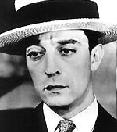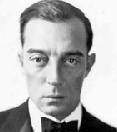

Buster Keaton
1895 - 1966


Buster Keaton
1895 - 1966
Biography: Joseph Frank (Buster) Keaton was born into a family of
vaudevillians. Joseph, his father, did an eccentric dance act and his mother,
Myra, danced and played the saxophone. He was the oldest of three siblings;
he had one brother, Harry (Jingles), and a sister, Louise, both of whom would
later appear with the rest of his family in some of his movie shorts. Buster
joined his parents' act at a very early age. It soon developed into the roughest
act on vaudeville, with Buster's father hitting his son with brooms and other
objects and throwing him around the stage. This is where Keaton learned his
amazing falls and stunts. He also later claimed that that was when he learned
to keep a straight face throughout any adversity. The dead pan got more laughs,
it also hid the pain.
Buster's movie career began in 1917. Ten days before he was due to start rehearsals for the Schubert Brothers' "The Passing Show Of 1917", a chance meeting with former vaudeville friend Roscoe (Fatty) Arbuckle changed his life. Arbuckle had been making movie shorts for a while with Sennett, and was just starting production with Joseph Schenck at the Norma Talmadge studio on THE BUTCHER BOY. He asked Buster if he would like to 'do a scene' with him. Keaton jumped at the chance, pulled out of "The Passing Show", and the rest is wonderful history.
He continued to work with Arbuckle until Fall 1919. In September of that year, he was given the chance to make his own movies; he made three. In 1920 Schenck bought the old Chaplin studio and renamed it the Keaton studio, giving Buster complete artistic and technical control over his productions. He was contracted to make eight movie shorts a year. He gathered together a technical crew and writers that would stay with him until the end of 1928, when MGM took over the Keaton Studio. In these early films can be seen the germination of many ideas, stunts and technical feats that were to make his feature films the phenomenal artistic achievements they were. He made his first independent feature, THE THREE AGES, in 1923. He had made nine more by 1928, when he lost control to MGM. Among these wonderful movies are THE GENERAL, Keaton's favorite, OUR HOSPITALITY , which co-starred his first wife, Natalie Talmadge, and featured their first of two sons (James) in the opening sequences. This has the remarkable stunt, when Keaton swings out over a waterfall and grabs the heroine just as she is about to go over the edge. After numerous viewings, it still has me on the edge of my seat! Other classics included STEAMBOAT BILL, JR., GO WEST and, although made after the take over, THE CAMERAMAN, the last real Keaton movie.
A mixture of marital troubles
_ he had married Natalie in 1921 _ and the loss of control over his film
making, took a heavy toll on Keaton. He began drinking heavily and became
'difficult' to handle at MGM. This subsequently lost him his contract with
them. Natalie divorced him and took their sons, denying him access to them.
This led to a complete breakdown, stays in various hospitals in an attempt
to dry him out, and a second, disastrous marriage and divorce. During this
dark period of his life, Keaton made several talkies. Sound had not been
responsible directly for the decline of work offers; he had a good voice.
The quality of the movies that did come his way were on the decline too.
By 1933 he was back to making two-reelers, this time for 'Educational Pictures
'. These were made on a very low budget in two or three days, and it showed.
Things did start to look up during 1937 when he was offered a job as gag
writer back at MGM were he wrote gags for, amongst others, Clarke Gable in
TOO HOT TO HANDLE and for the Marx Brothers in AT THE CIRCUS. In 1939 he
again appeared in a feature film, HOLLYWOOD CAVALCADE. More roles came his
way, a part in LI'L ABNER and THE VILLAIN STILL PURSUED HER. His face was
being recognized again.
In 1940 he married his third wife,
Eleanor Norris. She was 21, and he was 45. All their friends advised them
against it, but it proved to be the turning point and a marriage that would
last. Between 1947 and 1954, Buster and Eleanor appeared regularly in the
Cirque Medrano in Paris, where they were highly regarded as a double act.
Then he was offered a T.V. show, "The Buster Keaton Comedy Show". Its success
put him onto the major chat shows of the day, including Ed Sullivan ten times,
Garry Moore, as well as "This Is Your Life" and some wonderfully inspired
appearances on "Candid Camera". During the late 50's and early 60's, Keaton's
films were being rediscovered, restored and reshown. A new audience was discovering
Buster Keaton and liking him; he was beginning to get a cult following.
This biography was written by Wendy Warwick White, visit her homepage: Generally Buster